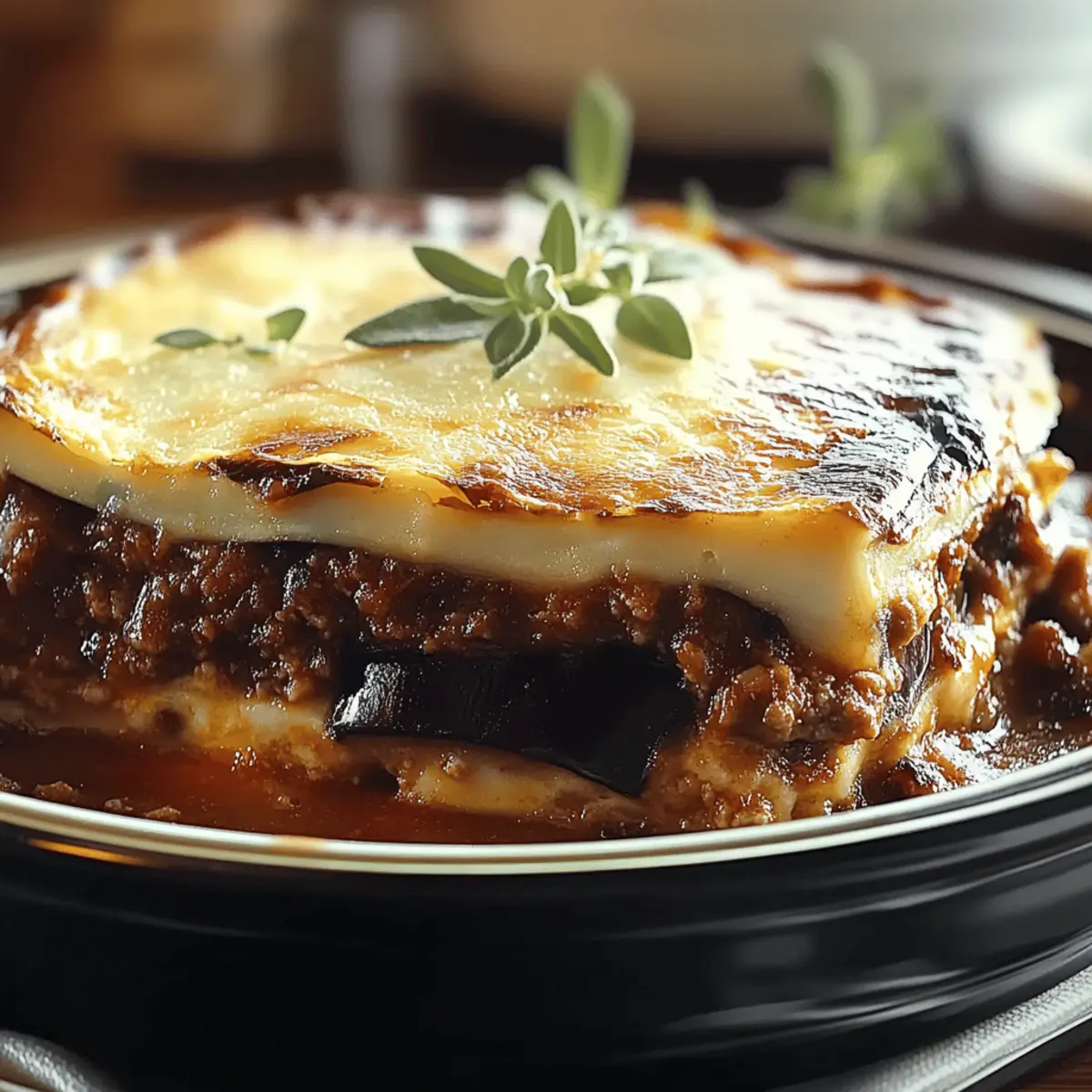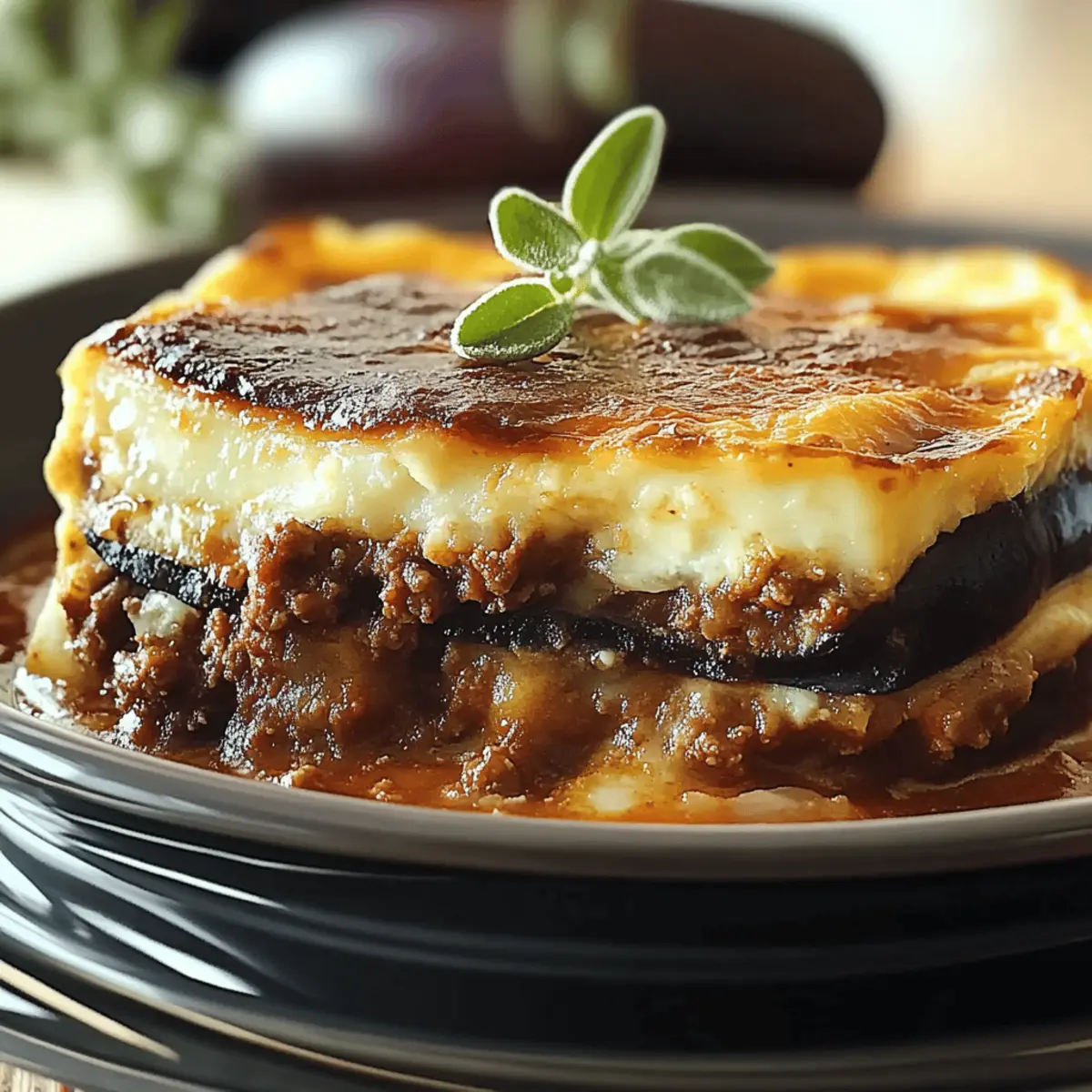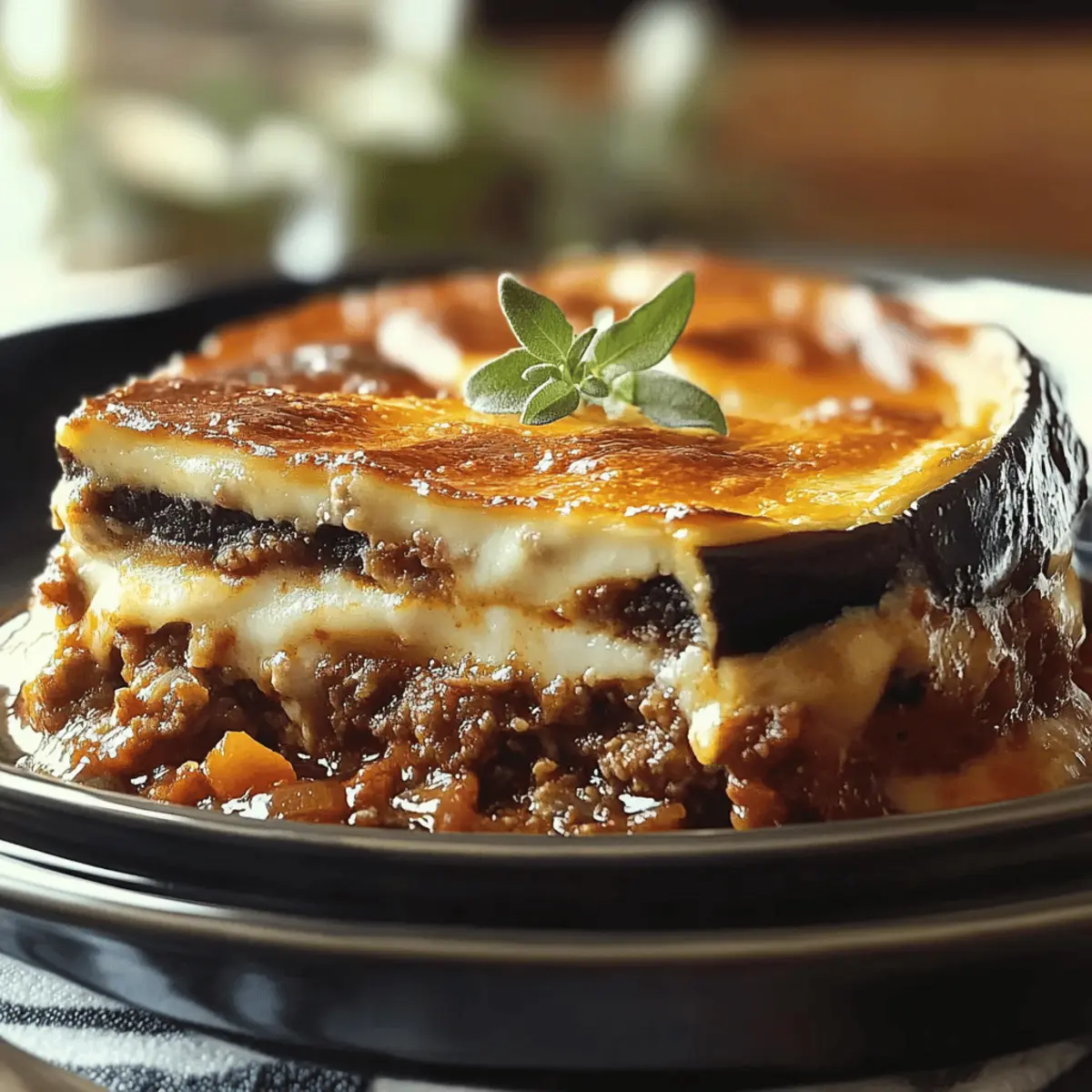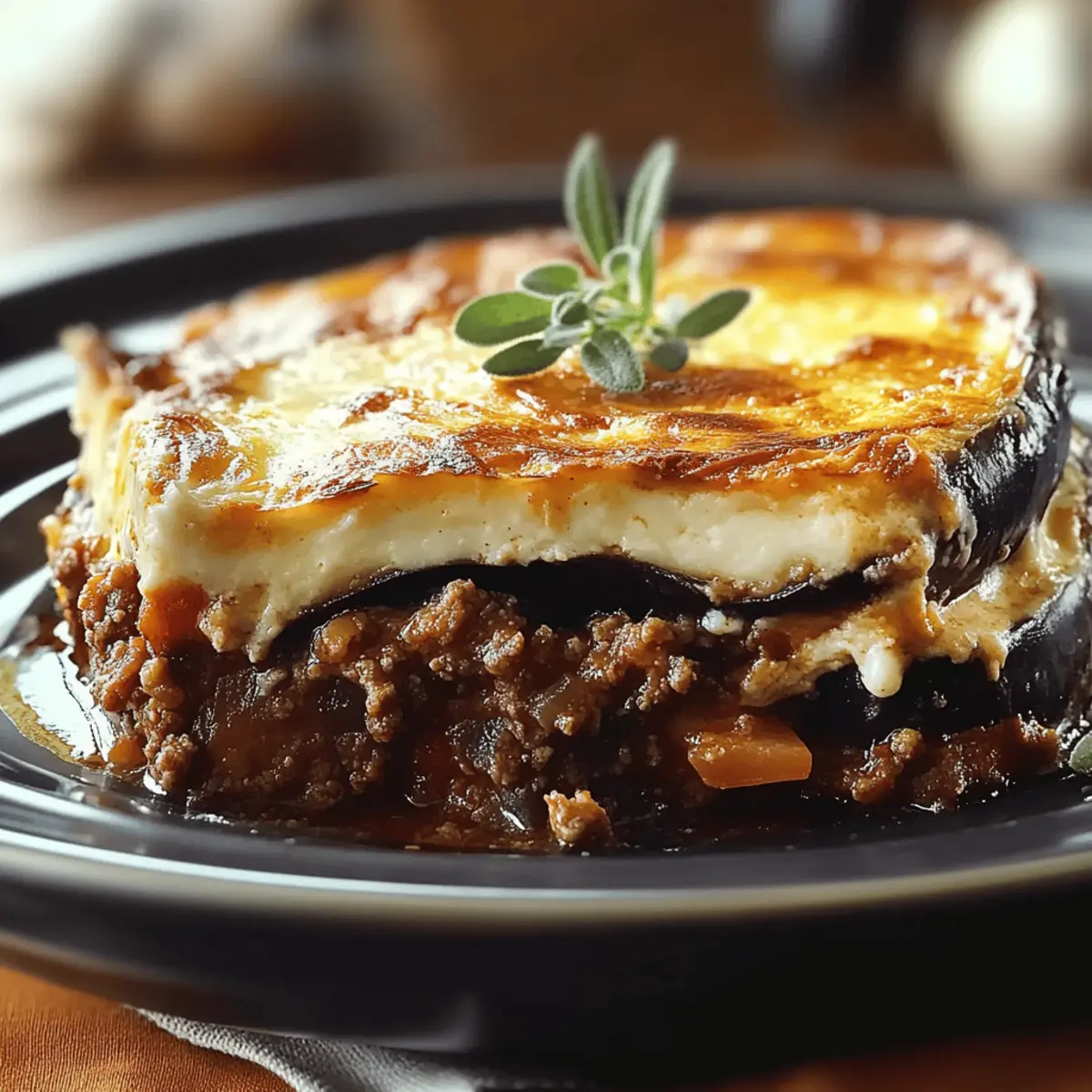As I prepped for dinner one evening, the tantalizing scent of spices wafted through the kitchen, instantly transporting me to sun-drenched Greek shores. That’s when I decided it was the perfect moment to indulge in a comforting Greek Moussaka. This dish is not just a meal; it’s a celebration of hearty layers featuring tender eggplant, a hearty meat sauce, and a creamy béchamel topping that embraces each ingredient beautifully. Whether you’re looking to impress dinner guests or simply soothe your soul with comfort food, this Greek Moussaka fits the bill. Plus, it’s a great make-ahead option, allowing you to whip it up in advance and warm it up when you’re ready to serve. Curious to discover how to create this Mediterranean delight? Let’s dive in!

Why is Greek Moussaka the ultimate comfort food?
Heartwarming Greek moussaka brilliantly combines rich layers of flavor and texture, making it the epitome of comfort food. Make-ahead friendly, you can prepare it in advance, popping it in the oven when it’s time to eat. Versatile ingredients allow for substitutions, from lamb to a vegetarian-friendly version with extra veggies, ensuring everyone leaves satisfied. Savory depth from the spiced meat sauce mingles perfectly with creamy béchamel, creating a delightful balance that keeps you coming back for more. For a complete meal experience, serve it alongside a fresh salad or crusty bread, reminiscent of those vibrant Greek tavernas. Discover more delightful recipes like Greek Chicken Gyros to expand your Mediterranean cooking repertoire!
Greek Moussaka Ingredients
• Here’s everything you need to create this comforting dish!
For the Vegetables
- Eggplants – The star of the dish that soaks up flavors beautifully; choose firm, glossy ones for the best results.
- Potatoes – Provides a hearty base layer; essential for that comforting structure.
- Zucchini – Adds moisture and texture; perfectly complements the eggplant for a delightful bite.
For the Meat Sauce
- Ground Meat (Beef or Lamb) – Offers savory depth; lean meat is best for a healthier option, with lamb providing an authentic flavor.
- Onion (Red) – Sweetness balances the dish; finely chop for a smooth sauce that melds nicely.
- Garlic – Enhances the meat sauce with aromatic goodness; minced for even distribution.
- Crushed Tomatoes – Forms the base of the sauce; canned ones are great for convenience and consistency.
- Red Wine – Elevates the dish with added depth; gives a lovely touch of acidity as well.
- Spices (Cinnamon, Nutmeg) – Impart that signature Greek flavor; use sparingly to avoid overpowering the dish.
- Herbs (Oregano, Thyme, Parsley) – Essential for freshness and Mediterranean notes; a mix adds complexity to flavor.
For the Topping
- Kefalograviera Cheese (or Parmesan) – Creates a delicious crust on top; kasseri or pecorino can also be delightful substitutes.
- Béchamel Sauce – The creamy star of the show; made with butter, flour, milk, egg yolks, nutmeg, and cheese for that luxe finish.
Step‑by‑Step Instructions for Greek Moussaka
Step 1: Prep Vegetables
Begin by slicing the eggplants, zucchini, and potatoes into ¼-inch rounds. Sprinkle salt on the eggplant slices and let them sit for about 30 minutes to draw out excess moisture. This step is crucial as it enhances the flavors and prevents sogginess. After 30 minutes, pat the eggplant slices dry with a paper towel.
Step 2: Fry Vegetables
In a large skillet, heat a generous amount of olive oil over medium heat. Fry the eggplant, zucchini, and potato slices in batches until they are golden brown, about 3-4 minutes per side. Make sure they don’t overcrowd the pan, as this can lead to steaming instead of frying. Once browned, drain them on paper towels to remove excess oil.
Step 3: Cook Meat Sauce
In a separate large saucepan, heat some olive oil over medium heat and sauté the chopped onion until it turns translucent, roughly 5 minutes. Add minced garlic and cook for an additional minute until fragrant. Next, add in the ground meat (beef or lamb), cooking until browned, about 8-10 minutes. Pour in the red wine, scraping any browned bits off the bottom, and let it simmer for 2-3 minutes before adding crushed tomatoes and spices. Cook and stir for 10-15 minutes until thickened.
Step 4: Make Béchamel Sauce
In a medium saucepan, melt 4 tablespoons of butter over low heat. Stir in an equal amount of flour, cooking for 2-3 minutes to form a roux, making sure it doesn’t brown. Gradually whisk in 2 cups of milk, stirring continuously until the sauce thickens and is smooth, about 5-7 minutes. Remove from heat and mix in egg yolks, a pinch of nutmeg, and ½ cup of cheese until fully combined and creamy.
Step 5: Layer Ingredients
Preheat your oven to 165°C (330°F fan) or 175°C (350°F conventional). In a large baking dish, start layering the Greek moussaka: first, place a layer of the fried potato slices, followed by a layer of eggplant and zucchini, then spread the rich meat sauce evenly on top. Finish with the creamy béchamel sauce, ensuring it covers the entire surface for a perfect golden top.
Step 6: Bake
Carefully place the baking dish in the preheated oven and bake for 40-45 minutes, or until the béchamel is bubbly and golden brown on top. Keep an eye on it in the final minutes to avoid over-browning. The Greek Moussaka is done when it emits a delicious aroma and the top is beautifully crusted.
Step 7: Rest
Once out of the oven, let the moussaka rest for at least 30 minutes before slicing. This resting period allows the layers to set, making it easier to cut into neat portions. Serve warm, perhaps alongside a fresh salad or some crusty bread, to share the joy of this heartwarming dish.

How to Store and Freeze Greek Moussaka
- Fridge: Store the cooled Greek moussaka in an airtight container for up to 3 days. This makes it easy to enjoy leftovers without losing flavor.
- Freezer: For longer storage, freeze the moussaka before baking. Wrap it tightly in plastic wrap and then in aluminum foil for up to 3 months. Thaw overnight in the fridge before baking.
- Reheating: To reheat, bake thawed moussaka at 175°C (350°F) for about 30-40 minutes or until heated through and golden on top. This ensures it retains its creamy, comforting texture.
- Make-Ahead Tips: Assemble your Greek moussaka in advance and store in the fridge for up to 24 hours before baking. This is great for meal planning or entertaining.
Expert Tips for Greek Moussaka
- Choose the Right Eggplant: Opt for firm, glossy eggplants to avoid bitterness and ensure they absorb the flavors beautifully.
- Don’t Rush the Frying: Fry vegetables in small batches to prevent steaming; this maintains their texture and flavor for the Greek moussaka.
- Layering is Key: Ensure even layers when assembling the moussaka, as this helps distribute flavors and textures throughout the dish.
- Perfect the Béchamel: Stir continuously while making the béchamel to avoid lumps; a strained sauce yields a creamy texture that elevates your dish.
- Resting Time Counts: Allow the moussaka to rest for at least 30 minutes after baking. This helps the layers firm up, making slicing easier.
Make Ahead Options
Making Greek moussaka ahead of time is a brilliant way to save on those busy weeknights! You can prep the entire dish—vegetables, meat sauce, and béchamel—up to 24 hours in advance. Just assemble the moussaka in your baking dish, cover it tightly with plastic wrap, and refrigerate. This keeps the flavors melding together beautifully. When you’re ready to serve, simply preheat your oven and bake it for about 40-45 minutes until it bubbles and the top is golden. For leftovers, store them in an airtight container in the fridge for up to 3 days; it reheats just as deliciously! This meal prep strategy makes dinner a snap, ensuring you can easily enjoy a homemade classic with minimal effort.
Greek Moussaka Variations & Substitutions
Feel free to play around with this delightful dish and make it your own with these fun variations!
-
Lamb Swap: Substitute ground beef with ground lamb for an authentic Mediterranean twist. The rich flavor of lamb truly elevates this dish.
-
Vegetarian Delight: Replace the meat with a medley of mushrooms, lentils, or even chickpeas to create a hearty vegetarian version that’s bursting with flavor.
-
Ricotta Béchamel: For a lighter touch, swap out traditional béchamel for a creamy ricotta mixture. This adds a delightful twist while keeping things smooth.
-
Spice It Up: Add a dash of cayenne pepper or red pepper flakes to the meat sauce for an extra kick of heat. It brings a pleasant warmth and depth to the flavors.
-
Cheese Options: If kefalograviera cheese isn’t available, feel free to use a creamy goat cheese or even feta for a tangy crust that complements the moussaka wonderfully.
-
Extra Veggies: Toss in additional veggies like bell peppers or spinach for a colorful and nutritious touch. Just sauté them briefly before layering.
-
Prep Ahead: Assemble the moussaka but don’t bake it; cover tightly and refrigerate for up to 24 hours. It’s a fantastic make-ahead option for busy nights!
-
Bread Crumb Topping: For a crispy finish, sprinkle panko breadcrumbs mixed with some olive oil and herbs over the béchamel before baking. This adds a delightful crunch on top!
Explore more delightful Mediterranean flavors with dishes like Greek Chicken Gyros or bring even more variety to your table with variations tailored to your family’s preferences!
What to Serve with Outrageously Delicious Greek Moussaka
As the warm, inviting aroma of baked moussaka fills your kitchen, consider these delightful pairings to create the perfect Mediterranean-inspired meal.
- Greek Salad: A crisp and refreshing contrast, this salad with tomatoes, cucumbers, and feta adds a burst of freshness that balances the dish’s richness.
- Crusty Bread: Serve warm, crusty bread alongside to soak up the succulent layers. Nothing beats a good bread for those delicious leftover béchamel sauce!
- Roasted Vegetables: A mix of seasonal roasted vegetables offers sweetness and texture, enhancing the comforting nature of the moussaka. Try adding zucchini and bell peppers for a pop of color!
- Tzatziki Sauce: This cool, creamy yogurt sauce with cucumber and herbs adds a refreshing zing that harmonizes beautifully with the heartiness of the moussaka.
- Red Wine: A glass of robust red wine enhances the deep flavors of the moussaka and enriches the dining experience, invoking coastal Greek tavern vibes.
- Baklava: For dessert, indulge in a slice of baklava. Its sweet, nutty layers and fragrant honey perfectly conclude a Mediterranean feast.
- Olives and Feta Platter: A simple appetizer of olives and feta cheese brings a touch of savory goodness, awakening the taste buds before diving into your moussaka.
- Grilled Halloumi: Adding grilled halloumi cheese brings a salty richness that’s delightful on the palate, creating a luxurious blend of textures with every bite of moussaka.
- Sparkling Water: Opt for a refreshing sparkling water with a slice of lemon to cleanse the palate and keep the meal feeling light and vibrant.
- Herbed Quinoa: A side of fluffy quinoa with herbs introduces a nutty flavor while providing a gluten-free option that complements the moussaka beautifully.

Greek Moussaka Recipe FAQs
What type of eggplants should I use for Greek moussaka?
Absolutely! Look for firm, glossy eggplants that feel heavy for their size. Avoid any with dark spots or bruises, as these can affect the flavor and texture. If you’re unsure, a typical medium-sized eggplant works great, providing that beautiful spongy texture we love.
How should I store leftover Greek moussaka?
Very! Once cooled, store your leftovers in an airtight container in the fridge for up to 3 days. Make sure it’s well-sealed to keep the flavors intact. If you want to enjoy it later, you could also freeze it!
Can I freeze Greek moussaka? How?
Absolutely! To freeze Greek moussaka, I recommend wrapping it tightly in plastic wrap and then aluminum foil, which will prevent freezer burn. It can be frozen for up to 3 months. When you’re ready to enjoy it, simply thaw it in the fridge overnight before baking it at 175°C (350°F) for about 30-40 minutes until hot and bubbly.
What can I do if my béchamel sauce is lumpy?
Very good question! If your béchamel sauce becomes lumpy, don’t worry! You can strain it through a fine-mesh sieve to remove lumps, ensuring a smooth texture. You can also return it to low heat and whisk vigorously while adding a bit more milk gradually; this can help break down the lumps and achieve that creamy consistency we all want.
Is Greek moussaka suitable for vegetarians?
Yes, it can be! I often make a vegetarian version by substituting the ground meat with a blend of diced mushrooms, bell peppers, or lentils for protein. This way, you can enjoy a hearty and delicious dish without losing the essence of Greek moussaka.
Should I let the Greek moussaka rest before serving?
Absolutely! Allowing the moussaka to rest for at least 30 minutes after baking is essential. This time lets the layers set, ensuring you can slice it neatly without it falling apart, and enhances the overall flavor too!

Heartwarming Greek Moussaka: Comfort Food at Its Best
Ingredients
Equipment
Method
- Slice the eggplants, zucchini, and potatoes into ¼-inch rounds. Sprinkle salt on eggplant and let sit for 30 minutes to draw moisture.
- Heat olive oil in a skillet. Fry eggplant, zucchini, and potatoes until golden brown, about 3-4 minutes per side. Drain on paper towels.
- In a saucepan, sauté onions until translucent. Add garlic and ground meat, cooking until browned, about 8-10 minutes. Pour in red wine and let simmer before adding crushed tomatoes and spices. Cook for 10-15 minutes.
- In another saucepan, melt butter. Stir in flour to form a roux, then gradually whisk in milk until thick and smooth. Stir in egg yolks, nutmeg, and cheese.
- Preheat oven to 165°C (330°F fan). Layer potatoes, eggplant, zucchini, meat sauce, and béchamel in a baking dish.
- Bake for 40-45 minutes until béchamel is bubbly and golden brown.
- Let moussaka rest for 30 minutes before serving.

Leave a Reply